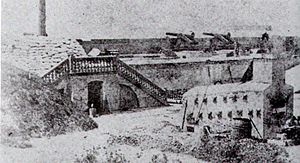Fort Moultrie
| Fort Moultrie | |
|---|---|
| Part of Fort Sumter National Monument | |
| Sullivan's Island, South Carolina, U.S. | |

Fort Moultrie in December 2006. The United States flag is at half-staff because of Gerald R. Ford's death.
|
|

Fort Moultrie in 1861.
|
|
| Coordinates | 32°45′33.81″N 79°51′28.05″W / 32.7593917°N 79.8577917°WCoordinates: 32°45′33.81″N 79°51′28.05″W / 32.7593917°N 79.8577917°W |
| Site information | |
| Owner | National Park Service |
| Open to the public |
Yes |
| Site history | |
| Built | 1776 |
| In use | 1776–1947 |
| Battles/wars | Battle of Sullivan's Island |
|
Fort Moultrie Quartermaster and Support Facilities Historic District
|
|

The former torpedo (naval mine) storage building at Fort Moultrie; today it serves as office space for the park.
|
|
| Location | Middle St. and Thompson Ave., bet. Stations 14 and 16.5, Sullivan's Island, South Carolina |
|---|---|
| Area | 5.3 acres (2.1 ha) |
| MPS | Sullivan's Island, South Island MPS |
| NRHP Reference # | 07000925 |
| Added to NRHP | September 6, 2007 |
Fort Moultrie is a series of fortifications on Sullivan's Island, South Carolina, built to protect the city of Charleston, South Carolina. The first fort, built of palmetto logs, inspired the flag and nickname of South Carolina, "The Palmetto State". It is named for the commander in the Battle of Sullivan's Island, General William Moultrie.
Fort Moultrie is the only area of the National Park System where the entire 171-year history of American seacoast defense (1776–1947) can be traced.
South Carolina patriots began to build a fort to guard Charleston, South Carolina, harbor in 1776. British Admiral Sir Peter Parker with nine British warships attacked the fort—named Fort Sullivan and incomplete—on June 28, 1776, near the beginning of the American Revolutionary War. The soft palmetto logs did not crack under bombardment but rather absorbed the shot; cannonballs reportedly even bounced off the walls of the structure. William Moultrie, commander of the 2nd South Carolina Regiment, and his four hundred men fought a day-long battle that ended with the heavily damaged British ships being driven from the area. This victory galvanized the Patriots' cause for independence. The fort hence took its name Fort Moultrie in his honor. Charleston locals celebrate "Carolina Day" to commemorate the bravery of the defenders of the fort.
During this battle, Moultrie flew a flag of his own design, authorized by the colonial government. It was later called the Moultrie flag or Liberty flag and became iconic to the Revolution in the South.
The British eventually captured Fort Moultrie as part of the Siege of Charleston in spring 1780 and renamed it Fort Arbuthnot. Nevertheless, the colonists won the war, and British troops departed in 1782, at which time the flag was presented in Charleston, by General Nathanael Greene, commander of the southern Regulars.
...
Wikipedia


